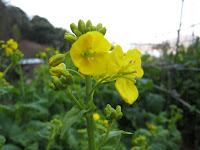I read Pierre-Francois Moreau ‘Supinoza et le spinozisme’ (Tramslated by Katsunori Matsuda and Yoshiro Higuchi / Hakusuisha.)
His logic is geometrically-shaped.
The daffodil get wet with rain.
Saturday, March 31, 2012
Friday, March 30, 2012
Rengyo
I read Osamu Ueno ‘Spinoza no Sekai’ (Kodanshagendaishinsho.)
Deus seu Natura.
The rengy is flower-arranged.
Deus seu Natura.
The rengy is flower-arranged.
Thursday, March 29, 2012
Chinchoge
I read harutsugu Yamaura 'Iesus no Kotoba (Kesengoyuaku)' (Bungeishinjyu.)
I have the utmost respect for Yuko who translate the Bible into Kesen language.
The chinchoge is in full bloom.
I have the utmost respect for Yuko who translate the Bible into Kesen language.
The chinchoge is in full bloom.
Wednesday, March 28, 2012
Sanshuyiu
I read Yukio Mishima ‘Kindainogakushu’ (Shinchosha.)
It contains eight stories of nogaku.
They are snappy.
The sanshuyu is in full bloom.
It contains eight stories of nogaku.
They are snappy.
The sanshuyu is in full bloom.
Tuesday, March 27, 2012
Cabbage
Monday, March 26, 2012
Nabana
Sunday, March 25, 2012
Pea
Saturday, March 24, 2012
Anzu
Friday, March 23, 2012
Thursday, March 22, 2012
Chinchoge
Tuesday, March 20, 2012
Apricot
Higanzakura
Monday, March 19, 2012
Tsubaki
Sunday, March 18, 2012
Tsubaki
Saturday, March 17, 2012
Ume
Friday, March 16, 2012
Ume
Thursday, March 15, 2012
Tsubaki
Wednesday, March 14, 2012
Aoki
Tuesday, March 13, 2012
Ume and Ferry
Monday, March 12, 2012
Cabbage
Sunday, March 11, 2012
Hakubai
Saturday, March 10, 2012
Hiraginanten
Friday, March 9, 2012
Tsubakiki
Thursday, March 8, 2012
Tsubaki
Wednesday, March 7, 2012
Tsubaki
Tuesday, March 6, 2012
Ume
Monday, March 5, 2012
Tsubaki
Sunday, March 4, 2012
Tsubaki
Saturday, March 3, 2012
Hakubai
Friday, March 2, 2012
Suisen
Thursday, March 1, 2012
Ume
Subscribe to:
Comments (Atom)






























